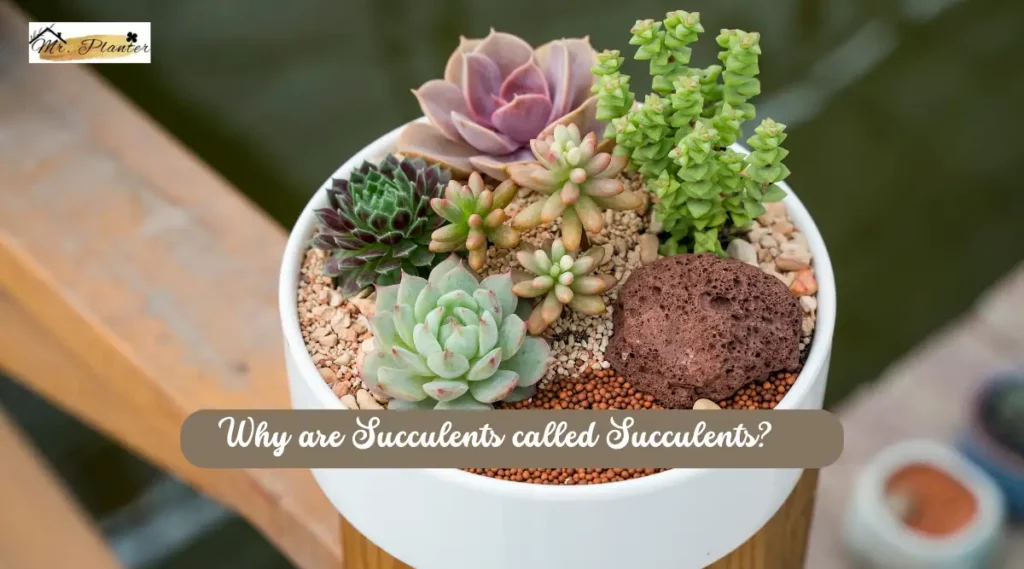Have you ever wondered why these adorable, low-maintenance plants are called “succulents”? The answer may surprise you.
Succulents are not just any ordinary plants – they have a unique ability to store water in their leaves, stems, and roots.
In fact, the word “succulent” comes from the Latin word “succulentus,” meaning juice or sap.
But how did these plants evolve to have such a remarkable adaptation?

Let’s dive into the fascinating history of succulents and uncover the reasons behind their curious name.
Why are Succulents called Succulents?
Succulents are called succulents because of their ability to store water in their leaves, stems, and roots.
These plants have adapted to survive in arid environments by developing thick, fleshy leaves or stems that can store water for long periods of time. The word “succulent” comes from the Latin word “succulentus” which means juice or sap.
Succulents are found in many different plant families, including cacti, agave, aloe, and echeveria. They are popular houseplants because they are easy to care for and come in a wide variety of shapes and colors.
Succulents are also commonly used in landscaping because they are drought-tolerant and can thrive in hot, dry climates.
In addition to their practical uses, succulents are also valued for their unique and striking appearance, which makes them a favorite among gardeners and plant enthusiasts.
Where did the name succulent come from?
The term “succulent” originates from the Latin word “succulentus,” which means “juicy” or “sap-filled.” This name perfectly describes the plants’ characteristic fleshy leaves and stems, which are designed to store water in arid environments.
Succulents have developed these unique adaptations as a survival mechanism, allowing them to thrive in regions with limited water availability.
The word “succulent” was first used in the botanical sense in the mid-18th century when scientists began to categorize and study these plants. Since then, succulents have gained popularity globally, adorning gardens, homes, and even wedding bouquets.
What does the Word Succulent Mean?
The word “succulent” refers to a type of plant that has thick, fleshy leaves or stems that store water.
These plants are often found in arid or semi-arid regions and have adapted to survive in dry conditions. Succulents come in a variety of shapes and sizes, from small, round rosettes to tall, spiky cacti.
Some common types of succulents include aloe vera, jade plant, and snake plant.
In addition to being aesthetically pleasing, succulents have several practical uses. Aloe vera, for example, is known for its healing properties and is often used in skincare products.
Some species of succulents are also edible and can be used in cooking or as a source of hydration in emergency situations.
When was the word succulent invented?
The word “succulent” was first used in the English language in the 1600s. It was used on 1601 in the writing of Philemon Holland who was a translator.

Over time, the term has come to be associated with a specific group of plants that have certain physical characteristics, such as thick, fleshy leaves or stems.
Today, succulents are popular among gardeners and plant enthusiasts due to their unique appearance and ability to thrive in a variety of conditions.
They are commonly used in landscaping, indoor gardening, and as houseplants. With their popularity on the rise, the term “succulent” has become a household name for many plant lovers around the world.
Source: Oxford Online Dictionary
Why are succulents so special?
Succulents have evolved various mechanisms to store water, ensuring their survival during prolonged periods of drought. One common way they store water is by accumulating it in their leaves.
The fleshy leaves act as reservoirs, storing water for future use. Some succulents, like the Aloe vera, have gel-filled leaves that contain a high concentration of water, providing them with a readily available water source.
In addition to storing water in their leaves, certain succulents store water in their stems or roots. For example, cacti have cylindrical stems that can store significant amounts of water. These specialized water storage tissues allow succulents to survive in harsh environments where water is limited.
What does a succulent symbolize in life?
Succulents have long been regarded as a meaningful symbol of love and commitment. These plants are often associated with enduring and timeless love, representing the idea that true love is steadfast and unwavering.
In addition to symbolizing stability in love, succulents are also believed to embody forgiveness and perseverance, qualities that are essential for any lasting relationship.
Beyond their significance in matters of the heart, succulents are also seen as a symbol of good fortune and prosperity. Many cultures believe that these plants bring good luck and wealth, and they are often used in rituals and ceremonies to attract abundance and longevity.
In Feng Shui, succulents are particularly revered for their ability to attract wealth and prosperity, making them a popular choice for home decor and office spaces.
In love and romance rituals, succulents are often used as a bonding agent, helping to strengthen and secure the connection between two people.
They are believed to have the power to make love last eternally, and are often given as gifts to signify the depth and endurance of a relationship.
Finally, succulents are also seen as a symbol of strength and tenacity, representing the idea that true love requires selflessness and dedication.
Whether used in love rituals or simply admired for their beauty and resilience, succulents are a powerful symbol of the enduring power of love.
The Science behind Succulent Leaves
The thick, fleshy leaves of succulent plants are the result of a unique adaptation to dry environments. These leaves are able to store water, allowing the plant to survive for long periods of time without rain.
The scientific term for this type of adaptation is “succulence,” which refers to the ability of a plant to store water in its leaves, stems, or roots.
The cells in succulent leaves are arranged in a way that allows them to hold large amounts of water.
They are also able to close their stomata (small openings on the leaves) during the day to prevent water loss through transpiration. This adaptation helps the plant to conserve water and survive in arid environments.
Succulent leaves also have a unique structure that helps them to absorb and retain water. The outer layer of the leaf (the epidermis) is covered in a waxy cuticle that helps to prevent water loss.
Beneath the epidermis is a layer of cells called the mesophyll, which is where photosynthesis takes place. Finally, the innermost layer of cells is called the parenchyma, which is where water is stored.
Overall, the science behind succulent leaves is a fascinating example of how plants have adapted to survive in harsh environments. By storing water in their leaves and having a unique cellular structure, succulent plants are able to thrive in regions where other plants would perish.
How succulents store water?
Succulent leaves are the key to their survival in harsh environments. These plants have evolved to have thick, fleshy leaves that are capable of storing large amounts of water.
Unlike other plants that lose water through their leaves, succulents have developed a unique adaptation to retain moisture. This adaptation is known as crassulacean acid metabolism (CAM).
CAM is a photosynthetic pathway that allows succulents to open their stomata and take in carbon dioxide during the night, when the air is cooler and less humid.
This allows them to minimize water loss through transpiration, as they can keep their stomata closed during the day when the heat and sunlight are at their peak. This efficient use of water is what makes succulents so well-suited to arid environments.
Additionally, succulent leaves have a thick, waxy coating called the cuticle. This cuticle helps to reduce water loss through evaporation and protects the plant from drying out. The waxy surface also reflects sunlight, preventing the leaves from overheating.
Succulent leaves come in a variety of shapes and sizes, from the paddle-like leaves of the Jade plant to the rosette formation of the Echeveria. Each shape and structure serves a purpose in maximizing water storage and minimizing water loss.
Adaptations in Succulents for survival in arid environments
Succulent plants have developed several adaptations to survive in arid environments where water is scarce.
One of the most notable adaptations is their ability to store water in their thick, fleshy leaves and stems. This allows the plant to survive for long periods of time without rain and to thrive in regions where other plants would perish.
Another adaptation in succulents is their ability to close their stomata during the day to prevent water loss through transpiration.
This helps the plant to conserve water and to survive in hot, dry environments. Some succulent plants, such as cacti, have also developed spines instead of leaves to reduce water loss through transpiration.
Succulent plants have also developed a unique root system that allows them to absorb water efficiently. Their roots are shallow and spread out widely, allowing them to capture as much water as possible from the soil.
Some succulent plants, such as the barrel cactus, have roots that extend deep into the ground to access water sources that are not available to other plants.
Overall, the adaptations in succulent plants for survival in arid environments are a fascinating example of how plants have evolved to thrive in challenging conditions.
By storing water in their leaves and stems, closing their stomata during the day, and developing a unique root system, succulent plants are able to survive in regions where other plants would struggle to grow.
Suggested Read: Cactus vs Succulents
Popular succulent species and their unique traits
Succulents are a diverse group of plants known for their ability to store water in their leaves, stems, and roots.
They come in a wide range of shapes, sizes, and colors, making them a popular choice for indoor and outdoor gardening. Here are some of the most popular succulent species and their unique traits:
Aloe Vera
Aloe vera is a well-known succulent species that is prized for its medicinal properties. The gel inside its leaves has been used for centuries to soothe burns, cuts, and other skin irritations.
Aloe vera is also a popular houseplant because it is easy to care for and can grow up to three feet tall.
Echeveria
Echeveria is a genus of succulent plants that are native to Mexico and Central America.
They are known for their rosette-shaped leaves, which come in a variety of colors, including green, blue, pink, and purple.
Echeverias are popular houseplants because they are easy to care for and can be propagated from leaves or stem cuttings.
Haworthia
Haworthia is a genus of small succulent plants that are native to southern Africa. They are known for their rosette-shaped leaves, which are often covered in small white or transparent spines.
Haworthias are popular houseplants because they are easy to care for and can be grown in small pots or terrariums.
Jade Plant
The jade plant, also known as Crassula ovata, is a popular succulent species that is native to South Africa. It is known for its thick, round leaves and its ability to grow into a small tree with a woody stem.
Jade plants are popular houseplants because they are easy to care for and can live for decades with proper care.
String of Pearls
The string of pearls, also known as Senecio rowleyanus, is a unique succulent species that is native to South Africa.
It is known for its long, trailing stems that are covered in small, round leaves that resemble pearls. String of pearls is a popular houseplant because it is easy to care for and can be grown in a hanging basket or trained to climb a trellis.
